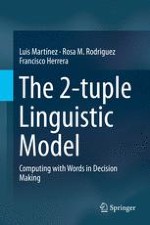2015 | OriginalPaper | Buchkapitel
7. 2-Tuple Linguistic Decision Based Applications
verfasst von : Luis Martínez, Rosa M. Rodriguez, Francisco Herrera
Erschienen in: The 2-tuple Linguistic Model
Aktivieren Sie unsere intelligente Suche, um passende Fachinhalte oder Patente zu finden.
Wählen Sie Textabschnitte aus um mit Künstlicher Intelligenz passenden Patente zu finden. powered by
Markieren Sie Textabschnitte, um KI-gestützt weitere passende Inhalte zu finden. powered by
